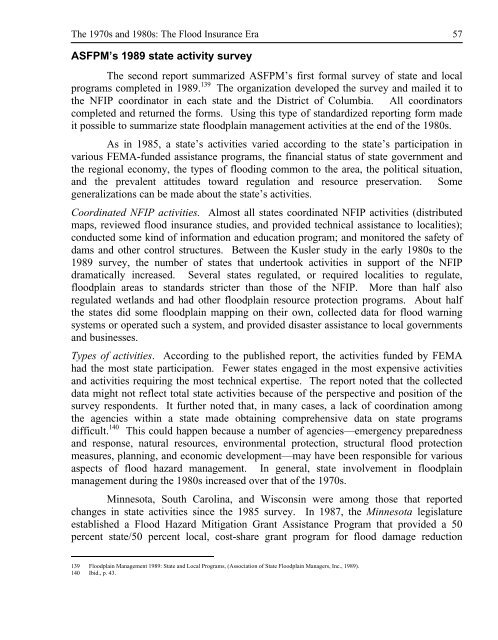The Nation's Responses To Flood Disasters: A Historical Account
The Nation's Responses To Flood Disasters: A Historical Account
The Nation's Responses To Flood Disasters: A Historical Account
Create successful ePaper yourself
Turn your PDF publications into a flip-book with our unique Google optimized e-Paper software.
<strong>The</strong> 1970s and 1980s: <strong>The</strong> <strong>Flood</strong> Insurance Era 57<br />
ASFPM’s 1989 state activity survey<br />
<strong>The</strong> second report summarized ASFPM’s first formal survey of state and local<br />
programs completed in 1989. 139 <strong>The</strong> organization developed the survey and mailed it to<br />
the NFIP coordinator in each state and the District of Columbia. All coordinators<br />
completed and returned the forms. Using this type of standardized reporting form made<br />
it possible to summarize state floodplain management activities at the end of the 1980s.<br />
As in 1985, a state’s activities varied according to the state’s participation in<br />
various FEMA-funded assistance programs, the financial status of state government and<br />
the regional economy, the types of flooding common to the area, the political situation,<br />
and the prevalent attitudes toward regulation and resource preservation. Some<br />
generalizations can be made about the state’s activities.<br />
Coordinated NFIP activities. Almost all states coordinated NFIP activities (distributed<br />
maps, reviewed flood insurance studies, and provided technical assistance to localities);<br />
conducted some kind of information and education program; and monitored the safety of<br />
dams and other control structures. Between the Kusler study in the early 1980s to the<br />
1989 survey, the number of states that undertook activities in support of the NFIP<br />
dramatically increased. Several states regulated, or required localities to regulate,<br />
floodplain areas to standards stricter than those of the NFIP. More than half also<br />
regulated wetlands and had other floodplain resource protection programs. About half<br />
the states did some floodplain mapping on their own, collected data for flood warning<br />
systems or operated such a system, and provided disaster assistance to local governments<br />
and businesses.<br />
Types of activities. According to the published report, the activities funded by FEMA<br />
had the most state participation. Fewer states engaged in the most expensive activities<br />
and activities requiring the most technical expertise. <strong>The</strong> report noted that the collected<br />
data might not reflect total state activities because of the perspective and position of the<br />
survey respondents. It further noted that, in many cases, a lack of coordination among<br />
the agencies within a state made obtaining comprehensive data on state programs<br />
difficult. 140 This could happen because a number of agencies—emergency preparedness<br />
and response, natural resources, environmental protection, structural flood protection<br />
measures, planning, and economic development—may have been responsible for various<br />
aspects of flood hazard management. In general, state involvement in floodplain<br />
management during the 1980s increased over that of the 1970s.<br />
Minnesota, South Carolina, and Wisconsin were among those that reported<br />
changes in state activities since the 1985 survey. In 1987, the Minnesota legislature<br />
established a <strong>Flood</strong> Hazard Mitigation Grant Assistance Program that provided a 50<br />
percent state/50 percent local, cost-share grant program for flood damage reduction<br />
139 <strong>Flood</strong>plain Management 1989: State and Local Programs, (Association of State <strong>Flood</strong>plain Managers, Inc., 1989).<br />
140 Ibid., p. 43.
















